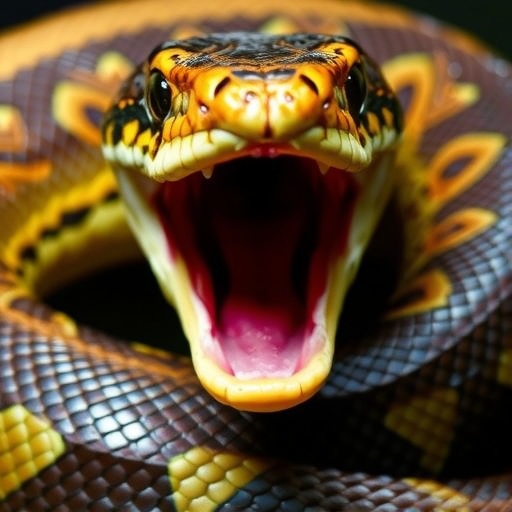Venomous snakes possess a lethal combination of speed, precision, and biomechanical ingenuity, enabling them to deliver some of nature’s most fearsome and fascinating attacks. These reptiles must operate on a timescale of just milliseconds, striking with incredible rapidity to ensure their fangs penetrate before prey can react—often within a mind-boggling 60 milliseconds. Until recently, capturing the intricacies of these deadly strikes in high definition remained elusive due to technological limitations. However, a groundbreaking study led by Alistair Evans and Silke Cleuren from Monash University, Australia, now reveals the astonishing kinematics of how venomous snakes from distinct families deploy their fangs to subdue prey.
The research team applied cutting-edge high-speed videography to analyze strikes of three major venomous snake families: vipers, elapids, and colubrids. Travelling from Australia to Venomworld, a venom extraction facility near Paris, France, they collaborated with Remi Ksas, a specialist in venom harvesting for pharmaceutical applications, and Anthony Herrel from the Museum national d’Histoire naturelle CNRS. Using a sophisticated setup of two synchronized cameras filming at 1,000 frames per second, the team recorded interactions between 36 snake species and a unique proxy prey: a cylindrical block of warm, muscle-like medical gel designed to mimic the texture and resistance of live prey muscle.
This innovative experimental design enabled the researchers to reconstruct the rapid, three-dimensional motion of snake strikes with unprecedented clarity. Viper striking dynamics emerged as true masters of precision and brute acceleration. The blunt-nosed viper (Macrovipera lebetina), for example, displayed astonishing acceleration rates reaching up to 710 meters per second squared, managing to embed its fangs in less than 22 milliseconds after initiating an attack. Such speed at the nanoscale of behavior places these reptiles among the fastest biological attackers on the planet.
In addition, species like Bothrops asper, regarded by some as the ultimate pit viper, demonstrated the highest velocities with strike speeds surpassing 4.5 meters per second after accelerations greater than 370 meters per second squared. Contrarily, the fastest elapid, the rough-scaled death adder (Acanthophis rugosus), attained maximal strike speeds of only about 2.5 meters per second, exhibiting a different biomechanical approach to prey capture.
A fascinating aspect of the vipers’ strike behavior is their active control over fang placement. Detailed frame-by-frame analysis revealed that vipers execute what might be likened to a “walking” motion with their fangs, carefully extracting and reinserting their needle-like teeth to optimize embedding angle and depth before injecting venom. This sophisticated manipulation ensures maximal venom delivery efficiency and reduces the risk of premature fang disengagement, underscoring an adaptive strategy that has evolved with lethal precision.
Elapid snakes such as the Cape coral cobra (Aspidelaps lubricus) and the forest cobra (Naja melanoleuca) adopted an altogether different method. The team observed them employing numerous repeated bites rather than a single precise strike. During these bursts, their powerful jaw muscles contracted rhythmically to squeeze venom with controlled force into prey tissue. This stealthier, multi-bite approach allows these snakes to modulate venom dosage and ensures envenomation even if initial strikes fail to fully penetrate.
The colubrids, whose fangs are positioned further rearward in the oral cavity, employed yet another unique modus operandi. Their strikes involved lunging over more extended distances than vipers or elapids, followed by clamping down on the prey and sweeping their jaws from side to side. This sweeping motion generates crescent-shaped lacerations, effectively creating a wound large enough to maximize venom infusion. Such biomechanical specialization highlights an evolutionary adaptation that complements fang morphology and venom toxicity in the context of prey capture strategies.
The study also revealed that venomous snakes do not always execute flawlessly coordinated strikes. On a remarkable occasion, a blunt-nosed viper miscalculated its strike distance, resulting in the breakage of its right fang upon impact. The presence of broken fangs inside snake feces hints that such occurrences may be relatively common in nature, necessitating frequent fang replacement through inherent regenerative mechanisms. This vulnerability introduces a dynamic aspect to the biomechanics of snake feeding that has implications for predator-prey interactions and venom delivery system durability.
Overall, the research establishes that venomous snakes operate with dramatically distinct kinematic strategies exquisitely tuned to their ecological niches and fang morphology. Vipers prioritize speed and fang positioning, elapids rely on rapid, forceful multi-biting to administer venom, and colubrids utilize jaw sweeping to inflict maximal tissue damage. Such variation reflects a remarkable example of convergent evolutionary optimization, where biomechanical constraints and predatory needs have sculpted highly specialized venom delivery behaviors.
These findings underscore the extraordinary evolutionary arms race between venomous snakes and their prey, where survival hinges on split-second actions executed with biomechanical perfection. This study not only advances our fundamental understanding of reptilian predators but also informs medical and pharmaceutical research by illuminating the mechanics underlying venom injection and fang functionality. The integration of high-speed 3D imaging represents a leap forward in experimental capabilities, offering a blueprint for future studies of rapid biological movements.
This work reminds us that beyond their feared reputation, venomous snakes embody an exquisite balance of physical power, precision control, and adaptive versatility. Their feeding strikes—silent and lethal—are among nature’s fastest feats of engineering. With technology now peeling back layers of mystery surrounding these dangerous animals, the full complexity of their predatory arsenal is coming into vivid focus for the first time, offering a deeper appreciation of biomechanical evolution in the animal kingdom.
Subject of Research: Animals
Article Title: Kinematics of feeding strikes in venomous snakes.
News Publication Date: 23-Oct-2025
Web References: http://dx.doi.org/10.1242/jeb.250347
References: Cleuren, S. G. C., Rule, J. P., Ksas, R., Herrel, A., Hocking, D. P. and Evans, A. R. (2025) Kinematics of strikes in venomous snakes. J. Exp. Biol. 228, jeb250347 doi:10.1242/jeb.250347
Keywords: Biomechanics, Reptiles
Tags: advanced imaging in herpetologybiomechanics of snake bitescomparative study of snake familiesevolutionary adaptations in snakeshigh-speed videography in wildlife researchkinematics of snake fangsMonash University snake researchprey capture strategies in snakesrapid striking mechanisms in reptilessnake predation techniquesvenom extraction for pharmaceuticalsvenomous snake strikes





